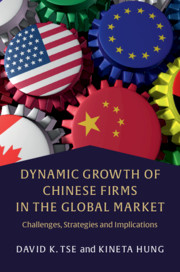Book contents
- Dynamic Growth of Chinese Firms in the Global Market
- Dynamic Growth of Chinese Firms in the Global Market
- Copyright page
- Contents
- Figures
- Tables
- 1 Introduction
- 2 China’s Economic Rise and Global Footprints of Chinese Firms
- 3 Globalisation of Chinese Firms Using Existing Paradigms
- 4 Globalisation of Chinese Firms Using New Paradigms
- 5 Challenges and Failures
- 6 Product Images and Market Acceptance of Chinese-Made Products
- 7 Corporate Social Responsibility
- 8 Managing National Image
- 9 China’s Technological Competence, Trade Relations, and Economic Co-operation
- 10 Holistic Conclusion through a Futuristic Lens
- Index
- References
4 - Globalisation of Chinese Firms Using New Paradigms
Published online by Cambridge University Press: 05 February 2020
- Dynamic Growth of Chinese Firms in the Global Market
- Dynamic Growth of Chinese Firms in the Global Market
- Copyright page
- Contents
- Figures
- Tables
- 1 Introduction
- 2 China’s Economic Rise and Global Footprints of Chinese Firms
- 3 Globalisation of Chinese Firms Using Existing Paradigms
- 4 Globalisation of Chinese Firms Using New Paradigms
- 5 Challenges and Failures
- 6 Product Images and Market Acceptance of Chinese-Made Products
- 7 Corporate Social Responsibility
- 8 Managing National Image
- 9 China’s Technological Competence, Trade Relations, and Economic Co-operation
- 10 Holistic Conclusion through a Futuristic Lens
- Index
- References
Summary
This chapter discusses several emerging globalisation models: the Springboard Model; its variant, the Leapfrog Model; the Mixed Model, a hybrid globalisation approach that leverages the combined benefits of administrative and market systems; and the Effectual Model, an appropriate for entrepreneurial firms. The discussion delineates the advantages and challenges of each model as well as the motivations for firms to adopt these models. Similar to , this chapter also traces the development of various exemplary firms (and their respective industries) that have successfully adopted these models. They include: China Merchants Bank (Springboard Model), Huawei (Leapfrog Model), CRRC (high-speed rail) (Mixed Model), and Techno (Effectual Model).
Keywords
- Type
- Chapter
- Information
- Dynamic Growth of Chinese Firms in the Global MarketChallenges, Strategies and Implications, pp. 53 - 82Publisher: Cambridge University PressPrint publication year: 2020



